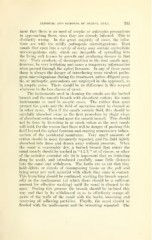Page 735 - My FlipBook
P. 735
EXPOSURE AND REMOVAL OF DENTAL PULP. 381
ment that there is no need of aseptic or antiseptic precautions
in approaching these, since they are already infected. This is
distinctly wrong. In the great majority of cases, the infec-
tions are with the mildly pathogenic microorganisms. Root
canals that open into a cavity of decay may contain saprophitic
microorganisms only, which are incapable of spreading into
the living soft tissues by growth and producing disease in that
way. Their products of decomposition in the root canals may,
however, be very irritating and cause a temporary inflammation
when passed through the apical foramen. In any of these eases
there is always the danger of introducing more virulent patho-
genic microorganisms during the treatment, unless diligent asep-
tic, or antiseptic, precautions are employed in the approach, as
in aseptic cases. There should be no difference in this respect
whatever in the two classes of cases.
The instruments used in cleaning the canals are the barbed
broach and the smooth broach with absorbent cotton ; the same
instruments as used in aseptic cases. The rubber dam must
protect the Y>arts. and the field of operation must be cleaned as
in other cases. Then if the canals contain fluid, this should be
carefully absorbed away as the first procedure by slight wisps
of absorbent cotton wound upon the smooth broach. This should
not be done by thrusting in as much cotton as the root canals
will hold, for the reason that there will be danger of pushing this
fluid beyond the apical foramen and causing unnecessary inflam-
mation of the peridental membrane. Very small amounts of
cotton should be used, frequently repeated, and the fluid lightly
absorbed into these and drawn away without pressure. "Wlien
the canal is reasonably dry, a barbed broach that enters the
canal loosely should be washed in "1-2-3," oil of cloves, or other
of the sedative essential oils (it is important that no irritating
drug be used), and introduced carefully some little distance
into the canal and withdrawn. The barbs are so cut that they
hold debris or shreds of decomposing tissue oti the pull and
bring away any such material with which they come in contact.
This broaching should be continued, washing the broach repeat-
edly in the medicament (of which there should be a sufficient
amount for elfective washing) until the canal is cleaned to its
apex. During this process the broach should be inclined this
way and that in its withdrawal so as to effectively scrape all
parts of the walls of the canal with the barbs, loosening and
removing all adhering particles. Finally, the canal should be
flooded with the medicament and the broaching repeated. The


